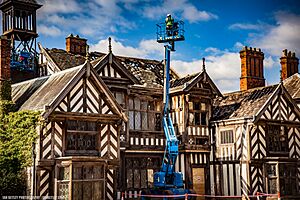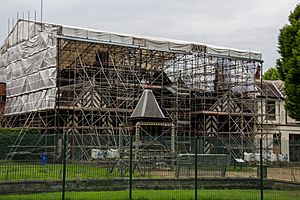Wythenshawe Hall facts for kids
Quick facts for kids Wythenshawe Hall |
|
|---|---|

Wythenshawe Hall in 2005
|
|
| Location | Wythenshawe, Manchester |
| Built | 1540 |
|
Listed Building – Grade II*
|
|
| Official name: Wythenshawe Hall | |
| Designated | 25 February 1952 |
| Reference no. | 1255034 |
Wythenshawe Hall is a historic house in Wythenshawe, Manchester, England. It was built in the 1500s and is made with a special timber-framed style. For nearly 400 years, it was the home of the Tatton family. You can find it in Wythenshawe Park, about 5 miles south of the city centre.
During the winter of 1643–1644, the house faced a big challenge. It was attacked by Parliamentarian soldiers during the English Civil War. The Tatton family and their Royalist friends fought hard, but the attackers had stronger weapons.
Later, the house was updated with new parts in the late 1700s and 1800s. These additions included a walled garden, an ice house, and glass houses. In 1926, Wythenshawe Hall and its park were given to Manchester Corporation. It opened as a museum for everyone to enjoy in 1930.
Sadly, the building was badly damaged by a fire in March 2016. After a lot of hard work and repairs, the hall finally welcomed visitors again in September 2022.
Contents
History of Wythenshawe Hall
The Tatton family owned land in Wythenshawe as early as 1297. Around 1540, Robert Tatton built Wythenshawe Hall as the family's main home. This beautiful timber-framed house was their residence for almost 400 years. It might have even had a moat around it long ago.
The English Civil War Siege
The hall faced a dramatic event during the English Civil War. Over the winter of 1643–1644, Parliamentarian forces, led by Robert Duckenfield, surrounded the house. The Royalists, led by Robert Tatton, defended it bravely. However, when the Parliamentarians brought two cannons from Manchester, the Royalists had to surrender on February 27, 1644.
After the war, the Parliamentarians took Wythenshawe Hall. But the Tatton family got it back by paying a fine of just over £700. Once they had their estate back, they made it much larger, growing it to about 2,500 acres.
A Gift to the City
In 1924, Robert Henry Grenville Tatton inherited the Wythenshawe estate. Manchester Corporation became interested in the land. They wanted to build a "garden suburb" to create new homes for people from crowded areas. By April 1926, Wythenshawe Hall and 250 acres of its land were sold. Ernest and Shena Simon bought them and then gave them to Manchester Corporation. They wanted the land to be used "solely for the public good."
Later that year, the corporation bought the rest of the estate. They then built one of Europe's largest housing estates on the land.
Repairs and Reopening
The hall received repairs in the 1950s. It was officially recognized as a Grade II* listed building on February 25, 1952. This means it's a very important historical building.
On March 15, 2016, a fire severely damaged the roof and an upper floor of the hall. The clock tower was also harmed. After extensive repairs costing £6.7 million, the building reopened to the public in September 2022.
Architecture of the Hall
The hall was partly rebuilt between 1795 and 1800 by Lewis Wyatt. It was changed again around 1840, possibly by Edward Blore. New parts added over time included a walled garden, an ice house, and glass houses. In the Victorian era, the dining room was updated, and a tenant's hall was built.
The timber-framed house has a main hall with two parts sticking out, called wings. It also has a porch and special bays. The entrance hall, sometimes called the ante-room, might have been a chapel a long time ago. It was later used as a billiards room before becoming the entrance hall in the 1870s.
Wythenshawe Hall as a Museum
In 1930, Wythenshawe Hall became a museum and art gallery. Most of the original furniture was taken by the Tatton family when they moved out in 1926. So, the furniture and paintings displayed in the museum came from the Manchester City Galleries collection.
Until 2007, there was a fun re-enactment every July. People would dress up and act out the 1643 siege of Wythenshawe Hall by Cromwell's troops.
By 2004, the hall was only open once a week for a few months each year. In 2010, it closed completely due to budget cuts. However, a group of friends started in September 2012 to help. They organized monthly open days and events at the hall. Thanks to them, the hall has been able to welcome visitors again.
Wythenshawe Park
Wythenshawe Park covers 270 acres of land around the hall. It's a great place with woodlands, flower beds, open grasslands, and meadows. The park also has sports facilities, Wythenshawe community farm, and a gardening center. North Lodge, a historic gate lodge, stands on the park's northern edge. It was built in the Tudor style in the mid to late 1800s.
In front of the hall, you can see a tall bronze statue of Oliver Cromwell. It stands on a granite base and was sculpted by Matthew Noble in 1875. This statue is also a Grade II listed item. It was moved to the park in 1968 from its original spot in Deansgate.
See also
- Grade II* listed buildings in Greater Manchester
- Listed buildings in Manchester-M23





